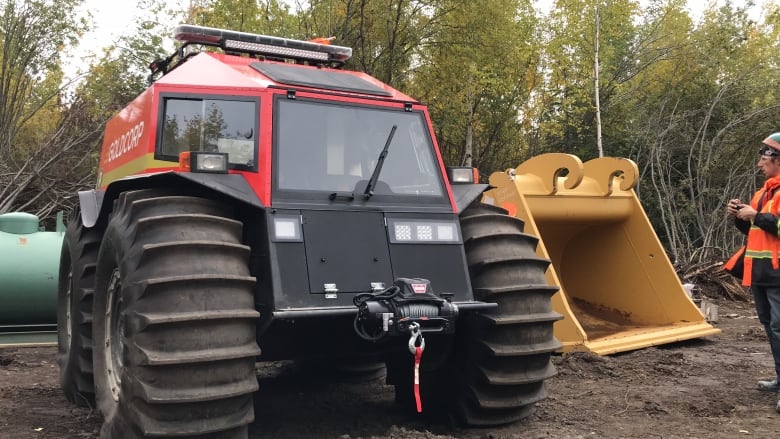Boom times ahead in two of Canada’s northern territories, report says

Good times are in store for Yukon (west Arctic) and Nunavut (east Arctic) in the coming years, according to a new economic analysis by the Conference Board of Canada.
Northwest Territories (N.W.T.), not so much.
The board’s economic forecast for the territories, released Thursday, predicts strong growth in Yukon and Nunavut between now and 2025, saying the two territories will outpace much of the country in terms of growth.
The N.W.T.’s economy, however, is expected to contract over that period, making that territory one of the weakest economic performers in the country, the board says.
The territorial forecast is based on a number of factors, including government spending, consumer behaviour, and population trends, but the main determinant for northern economies is still mining activity.
Both Yukon and Nunavut are expecting mines to open or expand operations in the next few years, while the N.W.T. will see comparatively little growth.
Yukon: New mines, low unemployment
The Conference Board says Yukon’s economy is expected to grow faster than almost any other province or territory over the next few years, largely thanks to two new mines that will go into production: Goldcorp’s Coffee Gold project near Dawson (west) and Victoria Gold’s Eagle project near Mayo (central).
The board also factors in the proposed Casino mine, which would be Yukon’s biggest mine, costing billions to build and employing hundreds or people. That project is still up in the air, though, as it’s been referred to the Yukon Environmental and Socio-economic Assessment Board (YESAB) for a full panel review.
The Conference Board’s analysis was done before Yukon’s only working mine, the Minto mine, was slated to shut down. But board spokesperson Marie-Christine Bernard says that wouldn’t significantly offset the growth expected from new mines.

The main concern for Yukon, according to Bernard may be finding enough skilled employees in the years ahead. Unemployment is already low in the territory, and would go lower still as new mines go into production.
“It does create some pressures, because it’s the skilled workers that are in high demand — and those are in high demand kind of across the country,” Bernard said.
Nunavut: Gold production to double
Nunavut’s rosy outlook is likewise pinned to growth in its mining sector — principally at Agnico Eagle’s Meliadine and Amaruq properties, and Sabina’s Back River project. Gold production in Nunavut is expected to double in the next couple of years.
That will mean lots of jobs in the territory, the report says.
“There will be no shortage of job creation in the next few years. Nunavut will add another 3,750 jobs between now and 2025, 1,300 of which will come from the boom in mining,” the report states.

The downside for Nunavummiut, according to the report, is that most of those new mining jobs will likely go to workers who fly in from elsewhere. More Nunavummiut will find work in service-based industries, the board predicts.
The report also says the Nunavut government could feel some spending pressure in the coming years, as the territorial population ages and requires more health services. The number of Nunavummiut aged 65 and over is expected to grow by an average of 9.7 per cent per year, the report says.
N.W.T.: Diamond production has peaked
“Challenging times are on the horizon for the Northwest Territories,” the report says.
It points to the N.W.T’s diamond mining industry, which has hit peak production and is expected to drop off in the coming years.
The Diavik, Gacho Kue and Ekati diamond mines will all be in production for a number of years — Diavik is the first scheduled to close, in 2025 — but the mines show little room growth, the board says.

The N.W.T. therefore has a bleaker employment outlook compared to the other territories. The unemployment rate will average about 7.3 per cent this year, and will remain roughly the same for the next decade, the board predicts.
“That will lead an average of 2,300 people to leave the territory each year for other parts of Canada, 390 more than the number of people who will come to the Northwest Territories,” the report says.
The N.W.T. currently has no operating metals mines, but there are two projects on the horizon — Canadian Zinc’s Prairie Creek mine and Fortune Minerals’ NICO mine. Neither is expected to go into production before 2021.
Related stories from around the North:
Canada: Nunavut, Canada iron mine gets federal OK to up production with regional Inuit support, CBC News
Finland: Gold mining in northern Finland hurts reindeer, says Natural Resources Institute, Yle News
Norway: A century of Norwegian coal mining in Svalbard comes to an end, The Independent Barents Observer
Russia: Ships carry ore from Canadian Arctic through Northern Sea Route, The Independent Barents Observer
Sweden: Iron mines in Arctic Norway could soon re-open, The Independent Barents Observer
United States: America’s most toxic site is in the Alaskan Arctic, Cryopolitics Blog



